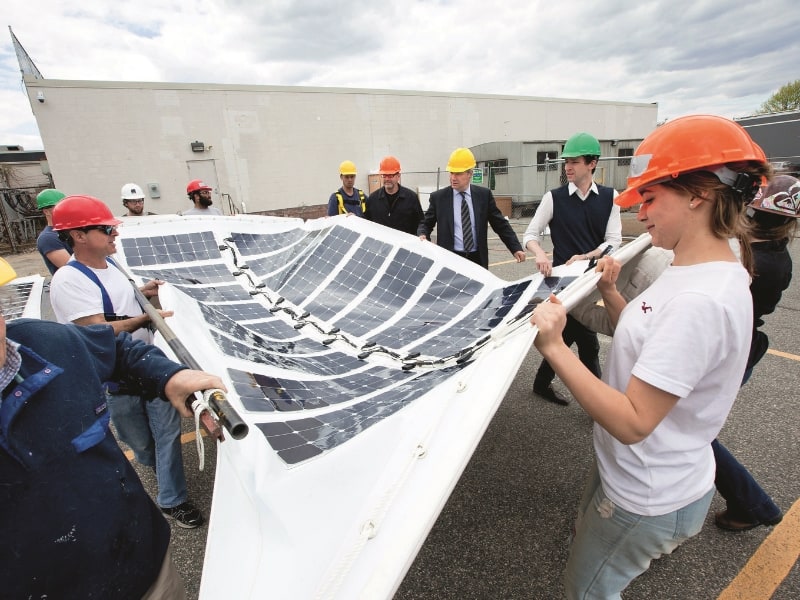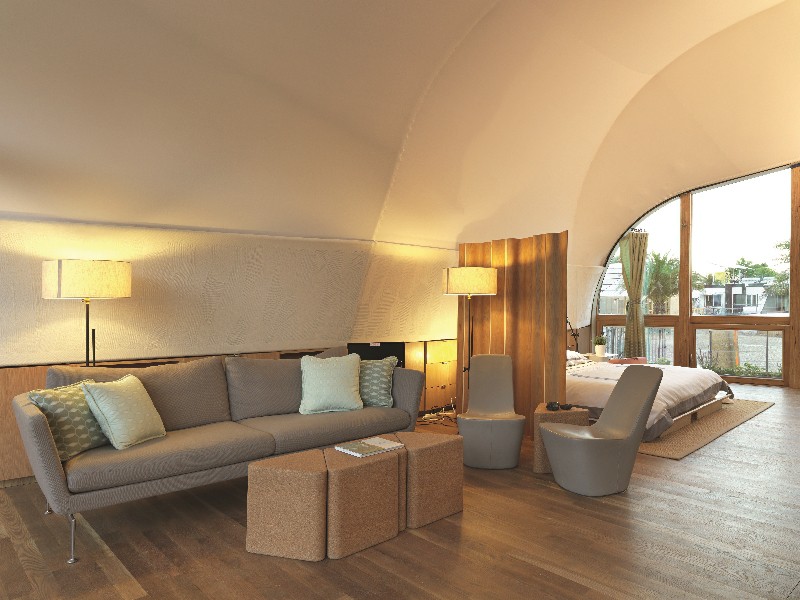Living in a material world
All kinds of materials are used in construction – but textiles and fabrics are typically reserved for post-construction (on beds, for example, and hanging in front of windows). A team of students is challenging that thinking now, in a bid to develop a more sustainable end product.
The Techstyle Haus, an innovative structure built predominantly from textiles and fabrics, was built and designed by students and teachers from Brown University and Rhode Island School of Design (RISD) in the US, in conjunction with students from the University of Applied Sciences in Erfurt, Germany.
The project, which was designed in part to challenge the thinking behind the current materials used in the building industry, drew attention after it was entered in last year’s Solar Decathlon competition. The competition challenges 20 collegiate teams to design and build sustainable homes, powered exclusively by solar energy and incorporating sustainable architecture and design.
“We realised textiles and fabrics provided an avenue for research that would allow us to showcase new potentials for a sometimes underappreciated material in the building industry,” says project manager Sina Almasi.

“We also had to maximise our energy efficiency and we used the strict Passive House Standard as our benchmark. We set out to research new material uses, develop more efficient construction methods and combine beautiful design with energy efficiency.”
The Passive House Standard is a voluntary standard for energy efficiency in a building, reducing its ecological footprint – most notably through the use of passive heating and cooling measures.
The team satisfied the requirements of the standard with their Techstyle Haus design, as well as incorporating a significant amount of aesthetic style – the house’s curved roof is as eye catching as it is functional.
“Sheerfill II Architectural Membrane is a structural membrane made of woven fibreglass and PTFE and takes the shape of a hyperbolic paraboloid,” explains Sina.
“Its shape was also engineered with the solar array in mind. The panels are laminated on a vinyl fabric that takes the shape of whatever structure it lies on. As a result, the two peaks of the house create an optimal summer solar angle, while the curvature allows the array to track the path of the sun over the course of a day.
To our knowledge this is the first time an array of this nature has been used in a residential application. As dictated by the competition, it is a 5kWh peak system and provides all the electricity for the house.”
This inventive design allows the house to be completely self-sufficient and then some, producing 50% more energy than it uses, while also allowing for a very fast assembly.
“The majority of the work is in pre-engineering, design and shop-fabrication for the steel structure and exterior membrane,” says Sina.
“But once they arrive on site, a crew can erect the structure and have the membrane cover up in three days, providing almost complete wind and water protection. It takes an additional one to two weeks to gradually pull the membrane fully-taut and to secure it to the structure.

“While that membrane is being tensioned, the insulation for the house gets installed, which is the most innovative aspect of the house. We invented a system of webbing using common ratchet straps to shape traditional fibreglass batt-insulation, to match the curvature of the roof membrane. The system can be installed and insulated in two to four days, depending on the number of people involved.”
The use of fabric in the Techstyle Haus extends to the interior design – a measure which could make spending hours painting your walls a thing of the past.
“The interior finish material of the house is also fabric, consisting of two layers installed onto an aluminium frame using a zipper system,” says Sina.
“Once the frame is in place, the inner layer functions as a visual block of the insulation system and takes a few hours to install. The finish layer is one continuous piece and can be installed in less than an hour. As opposed to painting, you could potentially have multiple variations of interior skins that you can change at will.”
Labour is a major cost of any construction and while that will always be a factor in any build, the Techstyle Haus serves as an interesting example of how to cut down on that expense.
“This speed in construction and assembly is a major success in our pursuit of advancing the building industry. A general rule of thumb is that half of the cost of construction goes to materials and the other half goes to labour,” explains Sina.
“If we can drastically cut the amount of labour needed on site and have it done in a shop, we can build more quickly and precisely while reducing the cost of construction. You could think of it as an alternative form of prefabrication that requires some skilled assembly. If you were to repeat the build of our design it would be reasonable to predict on-site times of two to three months.”
While the Techstyle Haus is small compared with most Australian houses, the technology and materials used in its build certainly have the capacity to transition to much larger structures.
“We have developed a system of insulating complexly curved surfaces in a quick and easy way, which could be expanded on in much larger applications,” says Sina.
“The insulation system in tandem with the ability of Sheerfill to span long distances with minimal structure makes it possible to envision a future of large complexes, which are able to minimise or eliminate their energy footprint.”
The Techstyle Haus has been permanently installed at the Domaine de Boisbuchet in Lessac, France, where it will be used to house students. This will also give the team the opportunity to observe how the structure performs over an extended period of time.
“We are hoping to monitor the building for a year or two and see how it performs. In the meantime, it will be seen and visited by the many artists, designers, architects and students that come to the Domaine de Boisbuchet,” says Sina.
“There is speculation about the creation of additional housing for up to 40 students, if it proves successful after observation and analysis. RISD and the Domaine de Boisbuchet have hopes of creating a long-term partnership.”
The team hopes its techniques and ideas can be embraced within the building industry, but to date doesn’t really have the means to commercialise the project.
“We are optimistic about seeing our system used on a broader scale, but as a school with limited resources, it would be difficult to commercialise it on our own,” explains Sina.
“Instead, we see this project as a learning tool for students and designers alike. We are hoping that this project is a source of inspiration to rethink the possibilities of design, construction and sustainable living.”
